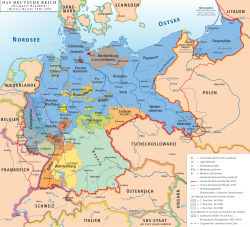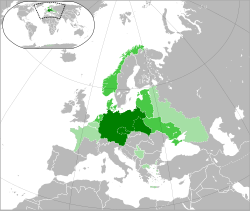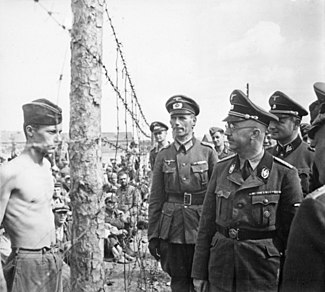
A hypothetical military victory of the Axis powers over the Allies of World War II (1939–1945) is a common topic in speculative literature. Works of alternative history (fiction) and of counterfactual history (non-fiction) include stories, novels, performances, and mixed media that often explore speculative public and private life in lands conquered by the coalition, whose principal powers were Nazi Germany, Imperial Japan, and Fascist Italy.
The first work of the genre was Swastika Night (1937), by Katherine Burdekin, a British novel published before Nazi Germany launched the Second World War in 1939. Later novels of alternative history include The Man in the High Castle (1962) by Philip K. Dick, SS-GB (1978) by Len Deighton, and Fatherland (1992) by Robert Harris. The stories deal with the politics, culture, and personalities who would have allowed the fascist victories against democracy and with the psychology of daily life in totalitarian societies. The novels present stories of how ordinary citizens would have dealt with fascist military occupation and with the resentments of being under colonial domination.
The literature uses the Latin term Pax Germanica to describe such fictional post-war outcomes. The term Pax Germanica was applied to the hypothetical Imperial German victory in the First World War (1914–1918). The concept is derived from that of Pax Romana and follows the trend of historians coining variants of the term to describe other periods of relative peace, whether established or attempted, such as Pax Americana, Pax Britannica, Pax Sovietica (see pax imperia; derived from Pax Romana).
Academics such as Gavriel David Rosenfeld in The World Hitler Never Made: Alternate History and the Memory of Nazism (2005), have researched the media representations of 'Nazi victory'.
Depictions of the Axis powers

Themes
Helen White stated that a hypothetical world in which Nazi Germany won the Second World War is a harsher and grimmer place to live in than the real world, where Nazi Germany and the Axis Powers lost the War in 1945. Speculative literature about hypothetical military victories by the Axis Powers have generally been English-language literary work from the British Commonwealth and the United States as such protagonists tend to experience events from the perspective of military defeat and foreign military occupation.
The literary tone of alternative history fiction presents the military victory of the Axis Powers as a melancholy background against which the reader sees the unfolding of political plots in a socially strained atmosphere of foreign occupation and socio-economic domination.
The social story of SS-GB (1978), by Len Deighton, concludes with a US commando raid into Nazi-occupied Great Britain, to rescue British nuclear scientists, while the British Resistance remains hopeful of eventual military liberation by the United States. In Clash of Eagles (1990), by Leo Rutman, the people of New York City rebel against the Nazi occupation of the US.
Some depictions focus on Nazism's contradictions, suggesting that even with military triumph, the system would eventually start to collapse under its own weight. In Fatherland (1992), by Robert Harris, the Greater German Reich faces economic crisis, forcing Hitler to pursue rapprochement with the US; at the story's conclusion, the protagonists thwart this effort by exposing the Holocaust to the American people. Harry Turtledove's In the Presence of Mine Enemies (2003) presents the Nazi world two generations after their victory in WWII, in a time and place that allowed political liberalization and democratization. The Hearts of Iron IV mod The New Order: Last Days of Europe shows the Reich declining thanks to economic stagnation and hostile relations with its former allies. Another example can be found in Wolfenstein: Youngblood's plot, set in an alternative 1980s; high ranked SS generals are seeking to establish a Fourth Reich which will replace the unstable and corrupt Reich after they lost most of their power since the liberation of America and the demise of Nazi key leaders such as Deathshead, Frau Engel and even Hitler himself in the 1960s.
Early depictions
The novel Swastika Night (1937) presents the post-war world born from the victory of the Axis Powers: a dictatorship characterized by much "violence and mindlessness" which are justified by "irrationality and superstition". Published two years before Nazi Germany began the Second World War in 1939, Swastika Night is a work of future history and not a work of alternative history. The book reviewer, Darragh McManus, said that although the story and plot of the novel are “a huge leap of imagination, Swastika Night posits a terrifyingly coherent and plausible [world]”, that “considering when it was published, and how little of what we know of the Nazi regime today was then understood, the novel is eerily prophetic and perceptive about the nature of Nazism”.
The short story, I, James Blunt (1941), is a work of wartime propaganda set in a fictional September 1944 when Great Britain is under Nazi rule. The story is told through the entries of a diary, which describe the social and economic consequences of military occupation such as British workers sent to the shipyards of Nazi Germany and Scotland to build warships to attack the U.S. The short story concludes with the diarist exhorting the reader to ensure that the story of the Nazi occupation of Great Britain remains fiction.
The novel We, Adolf I (1945) presents a Nazi victory in the Battle of Stalingrad which allowed Hitler to crown himself emperor of the world. In Berlin, the Nazis build an imperial palace featuring architectural elements of the Eiffel Tower and the Statue of Liberty. In the course of the story, the despot Hitler enters a dynastic marriage with the Japanese Imperial princess in an effort to produce a Fascist heir to rule the world after Hitler.
The Last Jew: A Novel (Ha-Yehudi Ha'Aharon, 1946) tells the future history of a Nazi world ruled by the League of Dictators. The League of Dictators plan the public execution of the last Jew as entertainment during the Olympic Games. Before they can realize the spectacular death of the last Jew, the Moon's excessive proximity to Earth, a negative consequence of Nazi lunar colonization, provokes a catastrophe that extinguishes life on planet Earth. The novel was written by the Jewish author Jacob Weinshal and should not be confused with Yoram Kaniuk's novel The Last Jew, which has been translated to English.
The stage play Peace in Our Time (1947), by Noël Coward explores the nature of fascist rule in London and examines the deleterious effects of military occupation upon the mental health of the common man and the common woman. As a playwright, Coward was included in the Gestapo's Black Book of enemies-of-the-state to be arrested upon completion of Operation Sea Lion, the Nazi conquest of Great Britain.
The novel The Man in the High Castle (1962) presents an Axis victory after Franklin D. Roosevelt is assassinated in 1933 and the United States is divided between Nazi Germany and Imperial Japan.
Later depictions
Additional notable depictions of Axis victory include:
Literature
- The Sound of His Horn by Sarban (1952)
- "Living Space" by Isaac Asimov (1956)
- The Big Time by Fritz Leiber (1957)
- Two Dooms by C. M. Kornbluth (1958)
- The Man in the High Castle by Philip K. Dick (1962)
- Wenn das der Führer wüsste by Otto Basil (1966)
- The Iron Dream by Norman Spinrad (1972) depicts a science fiction/fantasy allegory of a Nazi victory
- SS-GB by Len Deighton (1978)
- The Divide by William Overgard (1980)
- The Proteus Operation by James P. Hogan (1985)
- Thor Meets Captain America by David Brin (1986)
- Moon Of Ice by Brad Linaweaver (1988)
- The Last Article by Harry Turtledove (1988)
- Clash of Eagles by Leo Rutman (1990)
- Timewyrm: Exodus (Doctor Who novel) by Terrance Dicks (1991)
- Fatherland by Robert Harris (1992)
- No Retreat by John Bowen (1994)
- '48 by James Herbert (1996)
- Attentatet i Pålsjö skog by Hans Alfredson (1996)
- Making History by Stephen Fry (1996)
- Patton's Spaceship by John Barnes (part of The Timeline Wars series (1997))
- Against the Day by Michael Cronin (1999)
- After Dachau by Daniel Quinn (2001)
- Collaborator by Murray Davies (2003)
- In the Presence of Mine Enemies by Harry Turtledove (2003, the first 21 pages were originally a short story published in 1992)
- The Leader by Guy Walters (2003)
- Mobius Dick by Andrew Crumey (2004)
- The Plot Against America by Philip Roth (2004)
- Warlords of Utopia by Lance Parkin (2004)
- Farthing, Ha'penny, and Half a Crown, series by Jo Walton (2006–2008)
- Resistance by Owen Sheers (2007)
- The Conquistador's Hat by John Maddox Roberts (2011)
- Dominion by C. J. Sansom (2012)
- A Kill in the Morning by Graeme Shimmin (2014)
- The Madagaskar Plan by Guy Saville (2015)
- Mecha Samurai Empire series by Peter Tieryas (2016–2020)
Counterfactual scenarios are also written as a form of academic paper rather than necessarily as fiction and/or novel-length fiction:
- What If?: The World's Foremost Military Historians Imagine What Might Have Been contains "How Hitler Could Have Won the War" by John Keegan.
- Virtual History: Alternatives and Counterfactuals, edited by Niall Ferguson, contains "Hitler's England: What if Germany had invaded Britain in May 1940?" by Andrew Roberts and Niall Ferguson, and "Nazi Europe: What if Nazi Germany had defeated the Soviet Union?" by Michael Burleigh.
In the All About History Bookazine series, What if...Book of Alternate History (2019): Among the articles are What if...Germany had won the Battle of Britain? and What if...The Allies had lost the Battle of the Atlantic?
Film
- It Happened Here (1966), a British film directed by Kevin Brownlow
- Philadelphia Experiment II (1993)
- Fatherland (1994), based on the 1992 novel
- Jackboots on Whitehall (2010)
- Resistance (2011)
Television
- The Other Man (1964)
- Star Trek: The Original Series: "The City on the Edge of Forever" (1967)
- Doctor Who: "Inferno" (1970)
- An Englishman's Castle (1978)
- Darkroom: "Stay Tuned, We'll Be Right Back" (1981)
- Justice League: "The Savage Time" (2002)
- Star Trek: Enterprise: "Zero Hour"/"Storm Front" (2004)
- Misfits: Season 3, Episode 4 (2011)
- Danger 5:, Season 2, Episode 7 "Welcome to Hitlerland" (2015)
- The Man in the High Castle (2015–2019), an Amazon Studios series based on the 1962 novel
- SS-GB (2017), a BBC miniseries based on the 1978 novel
- Crisis on Earth-X (2017), a four-part Arrowverse crossover event between Supergirl, Arrow, The Flash, and Legends of Tomorrow
- The Plot Against America (2020), an HBO miniseries based on the 2004 novel
Comics
- "Blitzkrieg 1972", issue 155 of The Incredible Hulk (September 1972) depicts an alternate timeline where Nazis led by Captain Axis are attempting to invade New York City and battle an outnumbered U.S. Army assisted by the Hulk.
- The 1988 manga Kerberos Panzer Cop and related media in Mamoru Oshii's Kerberos saga depict an alternate universe where Nazi Germany develops "Protect Gear" powered exoskeletons early into the war, defeating the Allies and managing to occupy the Empire of Japan (part of the Allies in the saga's timeline). However, the 20 July plot succeeds, and the regime succeeding Hitler purges Nazism from the German Reich and restores the Weimar Republic, though authoritarianism is suggested to remain the dominant ideology.
- In the 2003–2004 Captain America story arc Cap Lives (Captain America Vol. 4, issues 17–20), Captain America awakens from suspended animation in 1964 to find that, due to a temporal anomaly, Nazi Germany has won World War II and conquered much of the world, including the United States. After dropping a nuclear bomb on the U.S., Nazi Germany took control of North America, renaming New York City as "New Berlin" and declaring it the capital of Nazi America. The Red Skull has become the Führer of the so-called "New Reich" and seeks to create an army of blonde, Aryan supermen or super soldiers based on Captain America's DNA. Alongside American resistance fighters that include Bucky Barnes, Nick Fury and his Howling Commandos, Peter Parker, Ben Grimm, Johnny Storm, Sue Storm, Reed Richards, Hank Pym, Janet van Dyne, Tony Stark, Donald Blake, Bruce Banner, Matt Murdock, Luke Cage, Frank Castle, and Stephen Strange, Captain America fights against the New Reich and succeeds in returning to the timeline in which he is originally meant to be.
- In DC Comics, Earth-X is an alternative Earth in which the Nazis developed the atomic bomb before the U.S. and won World War II.
- In the A-Next comic series by Marvel Comics, an alternate reality designated as Earth 9907 is depicted, in which the Red Skull survived and assumed leadership of the failing Third Reich, leading it into total world domination.
Video games
- Rocket Ranger (as a background story/alternate reality) by Cinemaware (1988)
- Turning Point: Fall of Liberty by Spark Unlimited (2008)
- Battlestations: Pacific by Eidos Interactive (2009)
- Wolfenstein: The New Order by MachineGames (2014)
- Wolfenstein: The Old Blood (2015)
- Wolfenstein II: The New Colossus (2017)
- Wolfenstein: Youngblood (2019)
- Wolfenstein: Cyberpilot (2019)
- We Happy Few (2018), a survival game set in an alternate mid-1960s England after the successful occupation of the country by Nazi Germany.
- Among the many alternate history timelines featured in the GURPS role-playing game Infinite Worlds is the highly dangerous timeline known as Reich-5, the worst of several Nazi-victorious alternate histories.
- In the grand strategy wargame Hearts of Iron IV by Paradox Interactive, many conversion mods set in a world with an Axis victory have been created.
- The New Order: Last Days of Europe (abbreviated as TNO), a mod for Hearts of Iron IV taking place in a Axis Victory in World War II where a Cold War is fought between Germany, United States and Japan. The mod has received praise for its rich storytelling and its dark and gloomy atmosphere.
- Thousand Week Reich, presents a German victory in World War II. In its timeline, the German capture the British Expeditionary Force at Dunkirk, which causes the British to sign a white peace with the Germany. Germany then is able to conquer the western portion of the Soviet Union following a long conflict. The Allies (at peace with Germany) are able to win against Japan in the Pacific. The mod begins with a Cold War between the United States-led Toronto Pact and the Germans.
Hypothetical German victory in World War I
Depictions of the Central powers
A similar but less frequent theme are alternate histories describing a hypothetical victory of Imperial Germany in World War I.
The first of this kind was When William Came (full name: When William Came: A Story of London Under the Hohenzollerns) written by British author Saki (the pseudonym of Hector Hugh Munro) and published in November 1913, thus at the time a future history rather than alternate history. Correctly predicting a war between Britain and Germany (in which Saki himself would be killed), the book assumes that Germany would win and impose a harsh occupation regime on the defeated Britain.
A much later example is Harry Turtledove's Curious Notions, describing a world dominated into the late 21st Century by the descendants of Kaiser Wilhelm, who promote monarchies everywhere and preserve Austria-Hungary and the Ottoman Empire as German satellites. In the book, the people of the occupied United States, like the rest of the world, are harshly oppressed by an omnipresent German secret police, similar to the role of the Gestapo in Nazi victory scenarios, but without the Nazi murderous antisemitism.
In the alternate timeline of Keith Laumer's Worlds of the Imperium, Imperial Germany won the First World War but failed to consolidate its victory, with a chaotic and highly destructive war, and eventually, a nuclear war, continuing to sweep the planet for generations.
Philip José Farmer's The Gate of Time mentions, but does not describe in detail, an alternate timeline in which Kaiser Wilhelm IV (rather than Adolf Hitler) controls an expansionist, imperialist Germany in this world's Second World War.
The alternate history mod Kaiserreich, Legacy of the Weltkrieg of the video game Hearts of Iron IV also covers a world where Germany won World War I, as the United States never joins the Entente. Causing Germany to gain territory in Central Africa and Eastern Europe, securing their gains under the Reichspakt military alliance and the Mitteleuropa economic alliance. The British and French mainlands were taken over by syndicalist revolutionaries, while their governments remain in exile in Canada and Algeria respectively. Italy is divided between a syndicalist government in the north, the Two Sicilies in the south, the Papal State in Rome, and the Austrian-supported Italian Republic in Lombardy and Venetia. Austria-Hungary and the Ottoman Empire survive the war and Bulgaria gains territory from Serbia and Greece. The Russian Civil War still occurs, but ends in the victory of the White movement. The United States continues to be in an economic depression by 1936.




